By Mark Hugo Lopez, Jens Manuael Krogstad and Jeffrey S. Passel
Pew Research Center
September 15, 2020 – Debates over who is Hispanic and who is not have fueled conversations about identity among Americans who trace their heritage to Latin America or Spain. The question surfaced during U.S. presidential debates and the confirmation of Sonia Sotomayor to the U.S. Supreme Court. More recently, it bubled up after a singer from Spain won the “Best Latin” award at the 2019 Video Music Awards.
So, who is considered Hispanic in the United States? And how are they counted in public opinion surveys, voter exit polls and government surveys such as the 2020 census?
The most common approach to answering these questions is straightforward:
Who is Hispanic? Anyone who says they are. And nobody who says they aren’t.
The U.S. Census Bureau uses this approach, as does Pew Research Center and most other research organizations that conduct public opinion surveys. By this way of counting, the Census Bureau estimates there were roughly 60.6 million Hispanics in the United States as of July 1, 2019, making up 18% of the total national population.
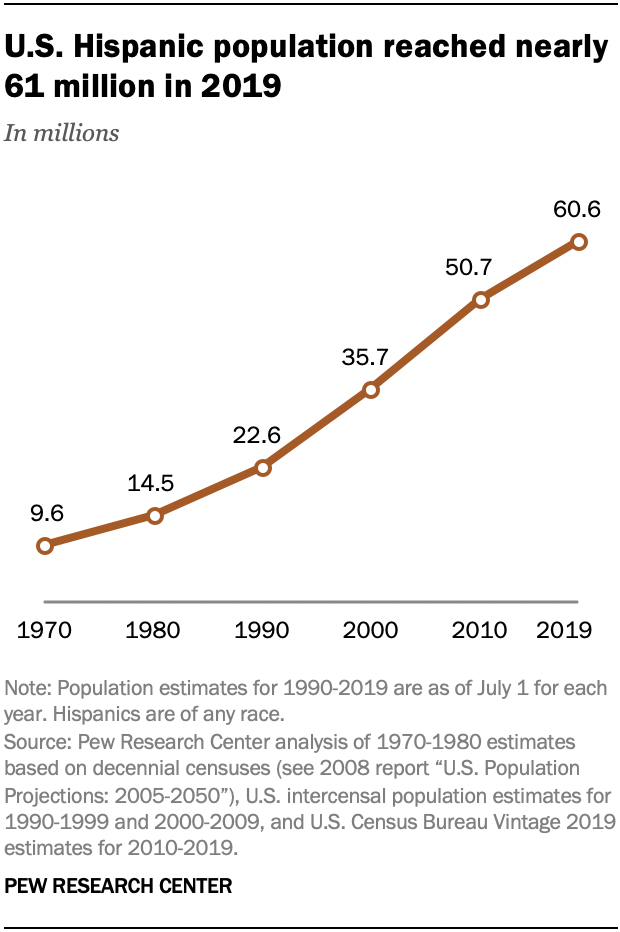
Behind the impressive precision of this official Census Bureau number lies a long history of changing labels, shifting categories and revised question wording on census forms – all of which reflect evolving cultural norms about what it means to be Hispanic or Latino in the United States today.
Here’s a quick primer on the Census Bureau’s approach of using self-identification to decide who is Hispanic.
I immigrated to Phoenix from Mexico. Am I Hispanic?
You are if you say so.
My parents moved to New York from Puerto Rico. Am I Hispanic?
You are if you say so.
My grandparents were born in Spain but I grew up in California. Am I Hispanic?
You are if you say so.
I was born in Maryland and married an immigrant from El Salvador. Am I Hispanic?
You are if you say so.
I was born in Argentina but grew up in Texas. I don’t consider myself Hispanic. Does the Census Bureau count me as Hispanic?
Not if you say you aren’t.
Of the 42.7 million adults with Hispanic ancestry living in the U.S. in 2015, an estimated 5 million people, or 11%, said they do not identify as Hispanic or Latino. These people aren’t counted as Hispanic by the Census Bureau or in Pew Research Center surveys.
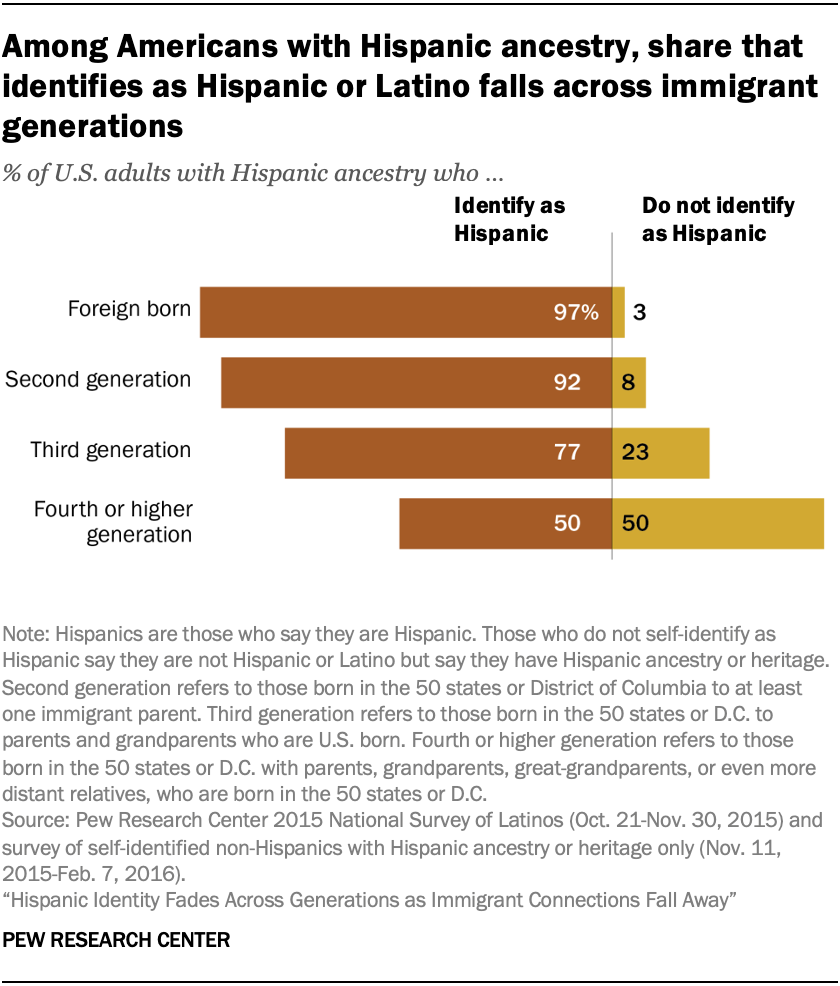
Hispanic self-identification varies across immigrant generations. Among the foreign born from Latin America, nearly all self-identify as Hispanic. But by the fourth generation, only half of people with Hispanic heritage in the U.S. self-identify as Hispanic.

But isn’t there an official definition of what it means to be Hispanic or Latino?
In 1976, the U.S. Congress passed the only law in this country’s history that mandated the collection and analysis of data for a specific ethnic group: Americans of Spanish origin or descent. The language of that legislation described this group as “Americans who identify themselves as being of Spanish-speaking background and trace their origin or descent from Mexico, Puerto Rico, Cuba, Central and South America, and other Spanish-speaking countries.” This includes 20 Spanish-speaking nations from Latin America and Spain itself, but not Portugal or Portuguese-speaking Brazil.
Standards for collecting data on Hispanics were developed by the Office of Management and Budget in 1977 and revised in 1997. Using these standards, schools, public health facilities and other government entities and agencies keep track of how many Hispanics they serve – the primary goal of the 1976 law.
However, the Census Bureau does not apply this definition when counting Hispanics. Rather, it relies entirely on self-reporting and lets each person identify as Hispanic or not. The 2020 census form asked the question this way:
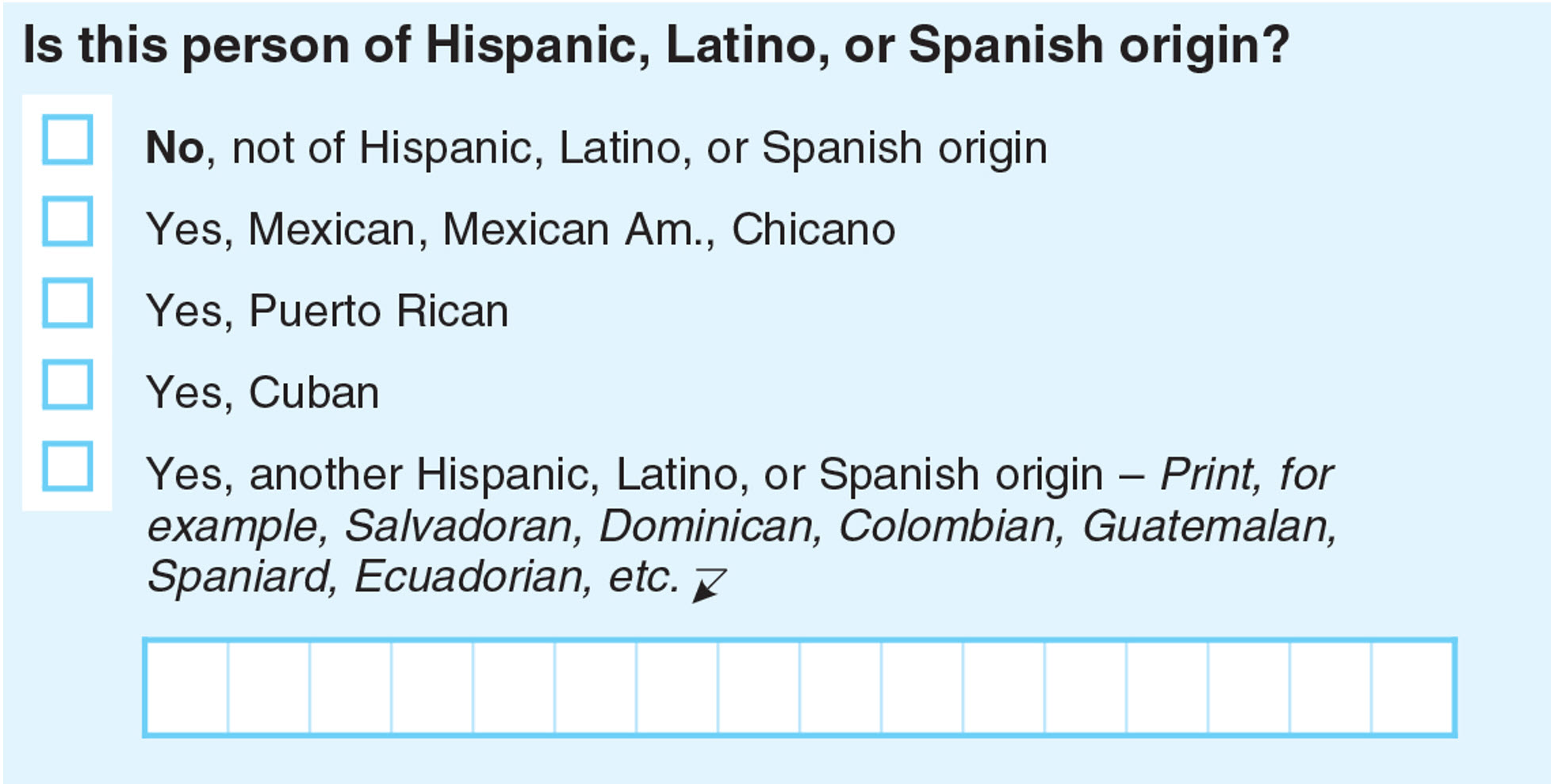
What’s the difference between Hispanic and Latino?
The terms “Hispanic” and “Latino” are pan-ethnic terms meant to describe – and summarize – the population of people living in the U.S. of that ethnic background. In practice, the Census Bureau most often uses the term “Hispanic,” while Pew Research Center uses the terms “Hispanic” and “Latino” interchangeably.
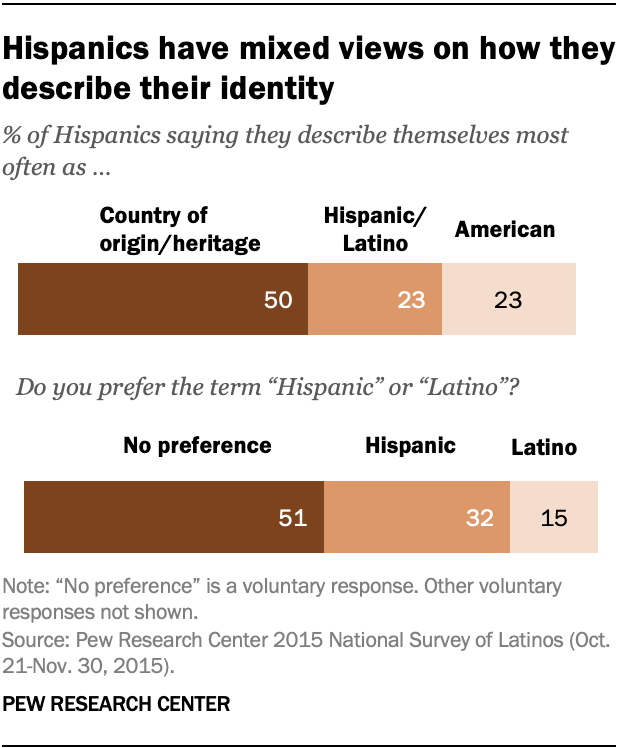
Some have drawn sharp distinctions between these two terms, saying for example that Hispanics are people from Spain or from Spanish-speaking countries in Latin America (this excludes Brazil, where Portuguese is the official language), while Latinos are people from Latin America regardless of language (this includes Brazil but excludes Spain). Despite this debate, the “Hispanic” and “Latino” labels are not universally embraced by the community that has been labeled, even as they are widely used.
Instead, Pew Research Center surveys show a preference for other terms to describe identity. A 2015 survey found that 50% of Hispanics most often describe themselves by their family’s country of origin: 23% use the terms Latino or Hispanic, and 23% most often describe themselves as American. As for a preference between the terms Hispanic or Latino, the survey found that 32% of Hispanics prefer “Hispanic,” 15% prefer the term “Latino” and the rest (51%) have no preference.
What about “Latinx”?
Another identity label is “Latinx,” which has emerged as an alternative to Hispanic or Latino in recent years. It is used by some news and entertainment outlets, corporations, local governments and universities to describe the nation’s Hispanic population. Yet the use of Latinx is not common practice, and the term’s emergence has generated debate about its appropriateness in a gendered language like Spanish. Some critics say it ignores the Spanish language and its gendered form, while others see Latinx as a gender- and LGBTQ-inclusive term.
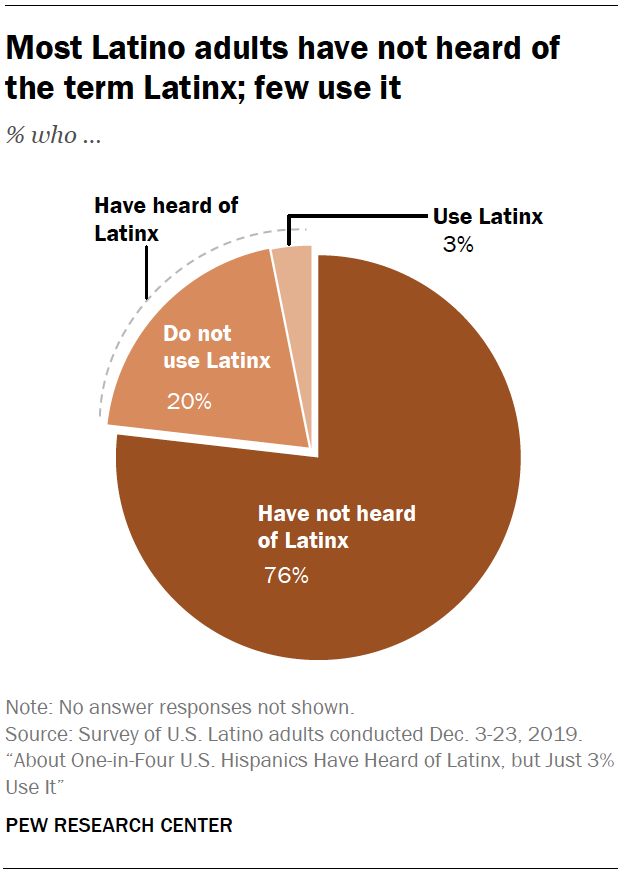
Only 23% of U.S. adults who self-identify as Hispanic or Latino have heard of the term Latinx, and just 3% say they use it to describe themselves, according to a bilingual survey of U.S. Hispanic adults the Center conducted in December 2019. Awareness and use vary across subgroups, with young Hispanics ages 18 to 29 among the most likely to have heard of the term – 42% say they have heard of it, compared with 7% of those ages 65 or older. Use is among the highest for Hispanic women ages 18 to 29 – 14% say they use it, compared with 1% of Hispanic men in the same age group who say they use it.
The emergence of Latinx coincides with a global movement to introduce gender-neutral nouns and pronouns into many languages whose grammar has traditionally used male or female constructions. In the U.S., the first uses of Latinx appeared more than a decade ago. It was added to a widely used English dictionary in 2018, reflecting its greater use.
The Census Bureau also asks people about their race and their ancestry. How do these responses come into play when determining if someone is Hispanic?
They don’t. In the eyes of the Census Bureau, Hispanics can be of any race, any ancestry or any country of origin. This results in varying patterns that relate to where people come from and how they choose to identify themselves on census surveys. For example, nearly all immigrants from Mexico (99%) called themselves Hispanic, according to a Pew Research Center analysis of the Census Bureau’s 2018 American Community Survey. By comparison, 92% of immigrants from Spain said so, as did 91% of immigrants from Argentina and 86% from Panama.
What about Brazilians, Portuguese and Filipinos? Are they Hispanic?
They are in the eyes of the Census Bureau if they say they are, even though these countries do not fit the federal government’s official definition of “Hispanic” because they are not Spanish-speaking. For the most part, people who trace their ancestry to these countries do not self-identify as Hispanic when they fill out their census forms. Only about 3% of immigrants from Brazil do so, as do 1% of immigrants from Portugal and 1% from the Philippines, according to Pew Research Center tabulations of the 2018 American Community Survey.
These patterns likely reflect a growing recognition and acceptance of the official definition of Hispanics. In the 1980 census, 18% of Brazilian immigrants and 12% of both Portuguese and Filipino immigrants identified as Hispanic. But by 2000, the shares identifying as Hispanic dropped to levels close to those seen today.
What people report on census forms are not subject to any independent checks, corroborations or corrections. This means, in theory, someone who has no Hispanic ancestors could identify as Hispanic and that’s how they would be counted.
Has the Census Bureau changed the way it counts Hispanics?
The first year the Census Bureau asked everybody in the country about Hispanic ethnicity was in 1980. Some efforts took place before then to count people who today would be considered Hispanic. In the 1930 census, for example, an attempt to count Hispanics appeared as part of the race question, which had a category for “Mexican.”
The first major attempt to estimate the size of the nation’s Hispanic population came in 1970 and produced widespread concerns among Hispanic organizations about an undercount. A portion of the U.S. population (5%) was asked if their origin or descent was from the following categories: “Mexican, Puerto Rican, Cuban, Central or South American, Other Spanish,” and “No, none of these.” This approach had problems, among them an undercount of about 1 million Hispanics. One reason for this is that many second-generation Hispanics did not select one of the Hispanic groups because the question did not include terms like “Mexican American.” The question wording also resulted in hundreds of thousands of people living in the Southern or Central regions of the U.S. being mistakenly included in the “Central or South American” category.
By 1980, the current approach – in which someone is asked if they are Hispanic – had taken hold, with some tweaks made to the question and response categories since then. In 2000, for example, the term “Latino” was added to make the question read, “Is this person Spanish/Hispanic/Latino?” In recent years, the Census Bureau has studied an alternative approach to counting Hispanics that combines the questions that ask about Hispanic origin and race. However, this change did not appear in the 2020 census.
###
Mark Hugo Lopez is director of global migration and demography research at Pew Research Center.
Jens Manuel Krogstad is a senior writer/editor focusing on Hispanics, immigration and demographics at Pew Research Center.
Jeffrey S. Passel is a senior demographer at Pew Research Center.
This article previously posted at Pew Research Center Fact Tank. Visit https://www.pewresearch.org/fact-tank/2020/09/15/who-is-hispanic/#more-322883










